Neem tree
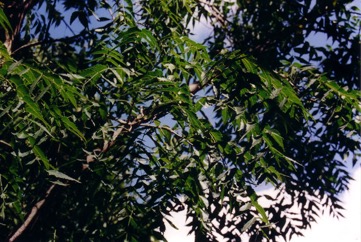
A tropical plant. It occurs in most of Africa in both wet and dry areas. It grows in the Sahel. It originally comes from India. They can stand temperatures up to 49°C. Temperatures below freezing kill the plant. In Africa trees mostly grow between 50 an 1500 m altitude. They do best in dry subtropical climates. It will grow on dry shallow soils but grows on most kinds of soils. It can grow in soils with pH of 5 but does best with pH of 6.2. It can grow in arid places. It suits hardiness zones 11-12.
Also known as:
Bevu, Dogon yaro, Geed hindi, Hithigas, Indian lilac, Ka dau, Kadu-nimb, Limba, Limbo, Limdo, Mahaneem, Mandvi, Margosa tree, Mirimiri, Neem dari, Niem, Nim, Nimba, Nimbay, Nimboni, Nimkauli, Nimpata, Nimu, Phak ka dao, Phak ki nin, Pichumarda, Sadao, Sau dau, Sdao, Sdav, Svay reanov, Tama, Tamaga, Turi forta, Vapa chettu, Vembu, Vepa, Veypa marum
Synonyms
- Antelea azadirachta (L.) Adelb.
- Azadirachta indica va. siamensis Valeton
- Melia azadirachta L.
- Melia indica Brand.
Edible Portion
- Fruit, Leaves, Flowers, Sap, Caution, Vegetable, Seeds, Seeds - oil
Where does Neem tree grow?
Found in: Africa, Algeria, Andamans, Angola, Antigua and Barbuda, Argentina, Asia, Australia, Bahamas, Bangladesh, Barbados, Benin, Botswana, Brazil, Burkina Faso, Burundi, Cambodia, Cameroon, Cape Verde, Central Africa, Central African Republic, CAR, Central America, Chad, Chile, China, Colombia, Congo DR, Côte d'Ivoire, Cuba, Djibouti, Dominica, Dominican Republic, East Africa, East Timor, Ecuador, Egypt, Equatorial-Guinea, Eritrea, Eswatini, Ethiopia, Fiji, French Guiana, Gabon, Gambia, Ghana, Guatemala, Guianas, Guinea, Guinée, Guinea-Bissau, Guyana, Haiti, Honduras, India, Indochina, Indonesia, Ivory Coast, Jamaica, Kenya, Laos, Lesotho, Liberia, Madagascar, Malawi, Malaysia, Maldives, Mali, Mauritania, Mauritius, Mexico, Morocco, Mozambique, Myanmar, Namibia, Nepal, Nicaragua, Niger, Nigeria, North Africa, North America, Northeastern India, Pacific, Pakistan, Panama, Paraguay, Peru, Philippines, Puerto Rico, Rwanda, Sahel, Sao Tome and Principe, Saudi Arabia, SE Asia, Senegal, Seychelles, Sierra Leone, Singapore, Somalia, South Africa, Southern Africa, South America, Sri Lanka, St. Kitts and Nevis, St Lucia, St. Vincent and Grenadines, Sudan, Suriname, Swaziland, Tanzania, Thailand, Timor-Leste, Togo, Trinidad-Tobago, Tunisia, Uganda, United States, Uruguay, Venezuela, Virgin Islands, West Africa, West Indies, Yemen, Zambia, Zimbabwe
Notes: Leaves contain 15 % protein. There are 2 Azadirachta species. It is used in medicine and as an insect repellant. It has anticancer properties.
Status: Famine food. It is cultivated. Leaves are sold in local markets. The pulp of the fruit is especially eaten by children.
Growing Neem tree
Cultivation: Trees can be grown from seed. Seed need to be fresh as they only remain viable for 1-2 weeks. Seeds planted in nurseries need to have roots pruned off regularly. Seedlings can be planted out after 14-18 weeks. A spacing of 5 x 10 m is suitable. Fruit fall naturally during the rainy season.
Edible Uses: The young leaves are cooked and eaten in India. They are eaten raw or fried along with other vegetables. They have a bitter taste. They are used in soups and curries. The flowers are used to flavour food. They are fried in oil or ghee. The pulp of the fully ripe fruit is eaten raw or cooked or used for drinks. Oil from the seeds can be used for cooking after being refined. The leaves and flowers are bitter unless cooked. The sap from the branches is fermented into an alcoholic drink and drunk. Caution: Alcohol is a cause of cancer. Caution: Alkaloids in the fruit and bark contain alkaloids that cause vomiting.
Production: It is a fast growing plant and can be 4-7 m in 3 years. A mature tree produces 20-50 kg of fruit. Trees can last for 100 years.
Nutrition Info
per 100g edible portion| Edible Part | Energy (kcal) | Protein (g) | Iron (mg) | Vitamin A (ug) | Vitamin c (mg) | Zinc (mg) | % Water |
|---|---|---|---|---|---|---|---|
| Fruit | - | - | - | - | - | - | |
| Leaves | - | - | - | - | - | - | |
| Flowers - flavour | - | - | - | - | - | - | |
| Sap | - | - | - | - | - | - |
Neem tree Photos

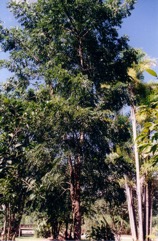
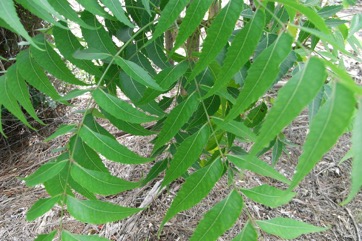
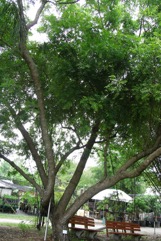
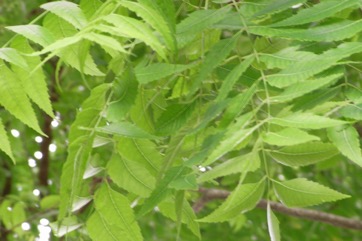
References
Ambasta S.P. (Ed.), 2000, The Useful Plants of India. CSIR India. p 64, 361
Anderson, E. F., 1993, Plants and people of the Golden Triangle. Dioscorides Press. p 203
Ara, R. I. T., 2015, Leafy Vegetables in Bangladesh. Photon eBooks. p 87
Arinathan, V., et al, 2007, Wild edibles used by Palliyars of the western Ghats, Tamil Nadu. Indian Journal of Traditional Knowledge. 6(1) pp 163-168
Bandyopadhyay, S. et al, 2009, Wild edible plants of Koch Bihar district, West Bengal. Natural Products Radiance 8(1) 64-72
Bandyopadhyay, S., et al, 2012, A Census of Wild Edible Plants from Howrah District, West Bengal, India. Proceedings of UGC sponsored National Seminar 2012
Banerjee, A., et al, 2013, Ethnobotanical Documentation of Some Wild Edible Plants in Bankura District, West Bengal, India. The Journal of Ethnobiology and Traditional Medicine. Photon 120 (2013) 585-590
Barwick, M., 2004, Tropical and Subtropical Trees. A Worldwide Encyclopedic Guide. Thames and Hudson p 40
Bekele-Tesemma A., Birnie, A., & Tengnas, B., 1993, Useful Trees and Shrubs for Ethiopia. Regional Soil Conservation Unit. Technical Handbook No 5. p 100
Belem, M., et al, 2017, Strategy of Conservation and Protection of Wild Edible Plants Diversity in Burkina Faso. ANADOLU 27 (2) 2017, 82- 90
Bernholt, H. et al, 2009, Plant species richness and diversity in urban and peri-urban gardens of Niamey, Niger. Agroforestry Systems 77:159-179
Bircher, A. G. & Bircher, W. H., 2000, Encyclopedia of Fruit Trees and Edible Flowering Plants in Egypt and the Subtropics. AUC Press. p 49
Bohra, N., et al, 2017, Ethnobotany of wild edible plants traditionally used by the local people in the Ramnagar regions from Nainital District, Uttarakhand, India. Biolife 5(1): 12-19
Bole, P.V., & Yaghani, Y., 1985, Field Guide to the Common Trees of India. OUP p 83
Brown, D., 2002, The Royal Horticultural Society encyclopedia of Herbs and their uses. DK Books. p 137
Bunderson, W. T. et al, 2002, Common Agroforestry Species in Malawi. Malawi Agroforestry Extension Project, Pubication No. 46, Lilongwe. p 31
Burkill, H. M., 1985, The useful plants of west tropical Africa, Vol. 4. Kew.
Cengel, D. J. & Dany, C., (Eds), 2016, Integrating Forest Biodiversity Resource Management and Sustainable Community Livelihood Development in the Preah Vihear Protected Forest. International Tropical Timber Organization p 120
Choudhary, S., 1999, Ethnobotany of Janjangbureh Island, The Gambia, West Africa. Honors thesis Dept. Biology City University of New York.
Chowdery, T., et al, 2014, Wild edible plants of Uttar Dinajpur District, West Bengal. Life Science Leaflets. 47:pp 20-36 http://lifesciencesleaflets.ning.com
Chowdhury, M. & Mukherjee, R., 2012, Wild Edible Plants Consumed by Local Communities of Maldah of West Bengal, India. Indian J.Sci.Res.3(2) : 163-170
Coronel, R.E., 1982, Fruit Collections in the Philippines. IBPGR Newsletter p 9
Cruz-Garcia, G. S., & Price, L. L., 2011, Ethnobotanical investigation of 'wild' food plants used by rice farmers in Kalasin, Northeast Thailand. Journal of Ethnobiology and Ethnomedicine 7:33
Dharani, N., 2002, Field Guide to common Trees & Shrubs of East Africa. Struik. p 55
Djihounouck, Y., et al, 2018, Diversité Et Importance Socio-Economique Des Espèces Fruitières Sauvages Comestibles En Zone Kasa (Sud-Ouest Du Sénégal). European Scientific Journal December 2018 edition Vol.14, No.36 ISSN: 1857 – 7881
Etherington, K., & Imwold, D., (Eds), 2001, Botanica's Trees & Shrubs. The illustrated A-Z of over 8500 trees and shrubs. Random House, Australia. p 109
Facciola, S., 1998, Cornucopia 2: a Source Book of Edible Plants. Kampong Publications, p 149
FAO, 1988, Traditional Food Plants, FAO Food and Nutrition Paper 42. FAO Rome p 88
Flora of Pakistan. www.eFloras.org
GAMMIE,
Gangwar, A. K. & Ramakrishnan, P. S., 1990, Ethnobotanical Notes on Some Tribes of Arunachal Pradesh, Northeastern India. Economic Botany, Vol. 44, No. 1 pp. 94-105
Gardner, S., et al, 2000, A Field Guide to Forest Trees of Northern Thailand, Kobfai Publishing Project. p 115
GUPTA & KANODIA,
Harris, F. M. A. and Mohammed, S., 2003, Relying on Nature: Wild Foods in Northern Nigeria. Ambio Vol. 32 No. 1. p 25-30
Hearne, D.A., & Rance, S.J., 1975, Trees for Darwin and Northern Australia. AGPS, Canberra p 28, Pl 8
Jackes, B.R., 2001, Plants of the Tropics. Rainforest to Heath. An Identification Guide. James Cook University. p 63
Jacquat, C., 1990, Plants from the Markets of Thailand. D.K. Book House p 74
Japanese International Research Centre for Agricultural Science www.jircas.affrc.go.jp/project/value_addition/Vegetables
Jardin, C., 1970, List of Foods Used In Africa, FAO Nutrition Information Document Series No 2.p 55 (As Antelaea azadirachta)
Kachenchart, B., et al, 2008, Phenology of Edible Plants at Sakaerat Forest. In Proceedings of the FORTROP II: Tropical Forestry Change in a Changing World. Bangkok, Thailand. (As var. siamensis)
Kahlon, L. K. & Singh, R., 2019, Traditional knowledge & Dynamics of edible plants of primitive tribal group ‘Paudi Bhuyan’ with changing demography migration patterns in Northern Odisha. Indian Journal of Traditional Knowledge Vol 18(1), pp 7-15
Khumgratok, S., Edible Plants in Cultural Forests of Northeastern Thailand. Mahasarakham University Thailand. (As Azadirachta indica var. siamensis)
Kintzios, S. E., 2006, Terrestrial Plant-Derived Anticancer Agents and Plant Species Used in Anticancer research. Critical Reviews in Plant Sciences. 25: pp 79-113
Krishen P., 2006, Trees of Delhi, A Field Guide. DK Books. p 242
Latham, P., 2004, Useful Plants of Bas-Congo province. Latham & DFID p 46
Latham, P. & Mbuta, A. K., 2014, Useful Plants of Bas-Congo Province, Democratic Republic of Congo. Volume 1. Salvation Army. p 67
Luczaj, L., et al, 2021, Wild food plants and fungi sold in the markets of Luang Prabang, Lao PDR. Journal of Ethnobiology and Ethnomedicine (2021) 17:6
Martin, F.W. & Ruberte, R.M., 1979, Edible Leaves of the Tropics. Antillian College Press, Mayaguez, Puerto Rico. p 92, 205
Maydell, H. von, 1990, Trees and shrubs of the Sahel: their characteristics and uses. Margraf. p 173
Mbuya, L.P., Msanga, H.P., Ruffo, C.K., Birnie, A & Tengnas, B., 1994, Useful Trees and Shrubs for Tanzania. Regional Soil Conservation Unit. Technical Handbook No 6. p 112
Maikhuri, R, K, and Gangwar, A. K., 1993, Ethnobiological Notes on the Khasi and Garo Tribes of Meghalaya, Northeast India, Economic Botany, Vol. 47, No. 4, pp. 345-357
Maydell, H. von, 1990 Trees and shrubs of the Sahel: their characteristics and uses. Margraf. p
Medhi, P. & Borthakur, S. K., 2012, Phytoresources from North Cachur Hills of Assam -3: Edible plants sold at Hflong market. Indian Journal or Natural Products and Resources. 3(1) pp 84-109
Mem. Mus. Hist. Nat. 19:221, t. 2, fig. 5. 1830
Natuhara, Y., et al, 2011, Uses of trees in paddy fields in Champasak Province, Southern Lao PDR. Landscape and Ecological Engineering. p 7
Onu P. N. and Aniebo A. O., 2013, Toxicity and nutritional assessment of aqueous Azadirachta indica (neem) leaf extract in broiler chicks, International Journal of Biosciences, vol.3, no.6, p.172.
Paczkowska, G. & Chapman, A.R., 2000, The Western Australian Flora. A Descriptive Catalogue. Western Australian Herbarium. p 294
Partha, P., 2014, Ethnobotany of the Laleng (Patra) Community in Bangladesh. Journal of Pharmacognosy and Phytochemistry. 2(6):173-184
Patiri, B. & Borah, A., 2007, Wild Edible Plants of Assam. Geethaki Publishers. p 24
Prachi, K., et al, 2012, Underutilized wild fruits of North Maharashtra. Journal of Research in Plant Sciences. (2012) 1:071-076
Pradhan, R., et al, 2020, Potential Wild Edible Plants and its Significance in Livelihood of Indigenous People of Male Mahadeshwara Hills, Karnataka. Economic Affairs Vol. 64, No. 4 pp. 01-14
Prixar, S., et al, 2006, Species composition, distribution and management of trees in paddy fields in central Laos. p 14
Rajendra, K.C., 2014. Prominent Non-Wood Forest Products of Te- rai and Siwalik Regions in Nepal. Food and Agriculture Organization, Kathmandu, Nepal. p 79
Recher, P, 2001, Fruit Spirit Botanical Gardens Plant Index. www.nrg.com.au/~recher/ seedlist.html p 4
Reddy, B. M., 2012, Wild edible plants of Chandrapur district, Maharashtra, India. Indian Journal of Natural Products and Resources. 3(1) pp 110-117
Royal Botanic Gardens, Kew (1999). Survey of Economic Plants for Arid and Semi-Arid Lands (SEPASAL) database. Published on the Internet; http://www.rbgkew.org.uk/ceb/sepasal/internet [Accessed 3rd May 2011]
Sahni, K.C., 2000, The Book of Indian Trees. Bombay Natural History Society. Oxford. p 55
Saikia, M., 2015, Wild edible vegetables consumed by Assamese people of Dhemaji District of Assam, NE India and their medicinal values. Archives of Applied Science Research, 2015, 7 (5):102-109 (As Melia indica)
Sarma, H., et al, 2010, Updated Estimates of Wild Edible and Threatened Plants of Assam: A Meta-analysis. International Journal of Botany 6(4): 414-423
Sarvalingam, A., et al, 2014, Wild edible plant resources used by the Irulas of the Maruthamalai Hills, Southern Western Ghats, Coimbatore, Tamil Nadu. Indian Journal of Natural Products and Resources 5(2):198-201
Sawian, J. T., et al, 2007, Wild edible plants of Meghalaya, North-east India. Natural Product Radiance Vol. 6(5): p 413
SAXENA,
Selvam, V., 2007, Trees and shrubs of the Maldives. RAP Publication No. 2007/12 p 38
SHANKARNARAYAN & SAXENA,
SHORTT,
Singh, H.B., Arora R.K.,1978, Wild edible Plants of India. Indian Council of Agricultural Research, New Delhi. p 39
Sujanapal, P., & Sankaran, K. V., 2016, Common Plants of Maldives. FAO & Kerala FRI, p 49
Sukarya, D. G., (Ed.) 2013, 3,500 Plant Species of the Botanic Gardens of Indonesia. LIPI p 142
Swaminathan, M.S., and Kochnar, S.L., 2007, An Atlas of Major Flowering Trees in India. Macmillan. p 77
Tanaka, Y & Van Ke, N., 2007, Edible Wild Plants of Vietnam. Orchid Press. p 93
Terra, G.J.A., 1973, Tropical Vegetables. Communication 54e Royal Tropical Institute, Amsterdam, p 27
Toppo, P. et al, 2016, Wild edible plants of Dhamtari district of Chhattisgarh, India. Van Sangyan Vol. 3, No. 4
Turreira Garcia, N., et al, 2017, Ethnobotanical knowledgeof the Kuy and Khmer people in Prey Lang, Cambodia. Cambodian Journal of Natural History 2017 (1): 76-101
WATT
Wild edible plants of Himachal Pradesh
World Checklist of Useful Plant Species 2020. Royal Botanic Gardens, Kew
www.worldagroforestrycentre.org/sea/products/afdbases/af
Yasukawa, K., Medicinal and Edible Plants as Cancer Preventive Agents. Drug Discovery Research in Pharmacognosy. p185 www.intechopen.com
Young, J., (Ed.), 2001, Botanica's Pocket Trees and Shrubs. Random House. p 120